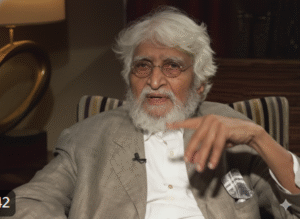
M.F. Husain
Art Begins With Your Roots The Powerful Truth Behind Creativity
Maqbool Fida Husain—celebrated worldwide as M.F. Husain—is regarded as the most iconic and internationally acclaimed Indian artist of the 20th century. Often hailed as the “Picasso of India,” Husain left an indelible mark on the global art world through his fearless creativity, distinctive style, and relentless pursuit of cultural expression. Born in 1913 in Maharashtra, he journeyed from humble beginnings to become a legendary figure in modern Indian art. Husain passed away in London in 2011, at the age of 97, leaving behind a vast and influential legacy.
Husain’s artistic journey was far from conventional. Mostly self-taught, he began his early career painting movie billboards across Mumbai to earn a living. This experience not only refined his sense of scale and composition but also shaped his bold, dramatic visual language. By the 1940s, he transitioned into fine art and soon attracted attention for his unique approach. His passion for reimagining traditional academic styles led to his invitation to join the Progressive Artists’ Group, a collective committed to modernizing Indian art after Independence.
Throughout his career, Husain became a symbol of artistic innovation. His vibrant canvases, dynamic brushstrokes, and fearless exploration of themes made him an instantly recognizable figure. No other Indian artist has brought as much global attention to Indian art—both within the country and abroad—as Husain.
A graduate of the prestigious Sir J.J. School of Art, Husain drew inspiration from Indian culture, history, and mythology. His subjects ranged from Mahatma Gandhi and Mother Teresa to epic narratives like the Mahabharata and Ramayana. Among his most famous motifs are his majestic horses, which he portrayed in powerful, fluid forms that have become iconic in his body of work.
Today, his paintings are housed in the collections of leading art institutions and renowned private collectors around the world. Over the course of his remarkable life, Husain received some of India’s highest civilian honors—including the Padma Shri, Padma Bhushan, and Padma Vibhushan—underscoring his monumental contribution to art and culture.
M.F. Husain remains not just an artist, but a symbol of boundless creativity—an individual whose work continues to inspire, challenge, and redefine the meaning of modern Indian art.
What inspired M.F. Husain to paint horses so often?
A: Horses were one of Husain’s most powerful symbols. He believed they represented strength, freedom, and timeless energy. His childhood memories, mythological stories, and admiration for the animal’s grace deeply influenced him. Over the years, horses became a signature element in his paintings, showing movement, emotion, and raw power.
Why do Husain’s paintings have bold lines and bright colors?
A: Husain used strong, sweeping lines and vibrant colors to convey emotion instantly. He wanted his art to speak directly to people—without needing long explanations. His style was influenced by traditional Indian folk art, street paintings, and modernism, but he mixed them in his own unique way to create impactful, energetic visuals.
What themes did M.F. Husain explore in his artworks?
A: Husain explored a wide range of themes, from Indian mythology (like the Ramayana and Mahabharata) to historical figures (such as Mother Teresa and Mahatma Gandhi). He often painted women, animals, festivals, and rural life, capturing India’s cultural diversity. His work reflected his deep connection to his roots and his curiosity about the world around him.
Why is M.F. Husain called the “Picasso of India”?
A: He earned this title because of his groundbreaking contribution to modern Indian art. Like Picasso, Husain constantly reinvented his style, broke traditional rules, and created a visual language that was bold, experimental, and instantly recognizable. His influence stretched far beyond India, making him one of the most respected artists globally.
